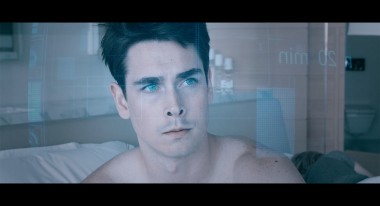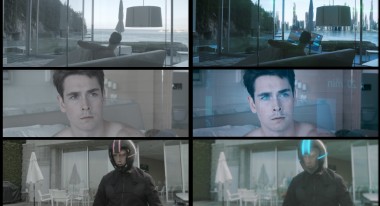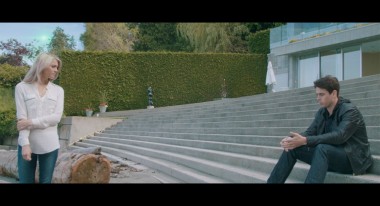 Back to selection
Back to selection
The Week In Cameras
Latest News About the Tools We Use by Michael Murie
Creating a Promotional Video for the Kindle Best-Selling Sci-Fi Series Post-Human

David Simpson is the author of the bestselling sci-fi novel series Post-Human. There are currently five books in the series, with two more planned. Born in Ireland, he has lived in Vancouver since 2000 and believed he would end up a teacher of English until he discovered self-publishing on the Kindle.
Having had success self-publishing, he hoped to create a promotional video for the series that might lead to the production of an actual movie. The resulting video represents what Simpson thinks the opening sequence of a Post-Human film might look like.
The truly fascinating part of the story is that after a couple of false starts, and with no production experience, Simpson ended up producing the promotional video himself, for a budget of $10,000, shooting with a camera he bought just for the purpose. Simpson really has two stories to tell; how he went about publishing his books, and how he came to be a filmmaker.
Filmmaker: Have you always been a writer?
Simpson: I was in university for literature, taking creative writing classes as I had an eye on eventually becoming a novelist. I didn’t want to have a life sentence teaching English in universities, even though I actually really enjoyed it. But there’s a difference between something you enjoy and a vocation, and I really wanted to be a novelist.

This was pre-Kindle days, so it was a lot harder to get published. In November of 2011 I read an article about an author named Amanda Hawking, who had become the second self-published eBook author to sell a million copies. That day changed my life because I realized, what am I waiting for? I don’t have to have this dream to one day get a publisher. I had a couple of books that were ready to go, and a month later I had a best seller.
Filmmaker: You self-published your books, but what possessed you to become a filmmaker?
Simpson: I’ve always envisioned Post-Human as films. When I wrote the books I think part of their success is that I had taken screenplay writing at the University of British Columbia and had realized that they teach literature a lot differently — even if it’s the same instructor — than they teach screenwriting. In screenwriting they make sure that you have your act reversals, and it’s got to have a certain pace, whereas in literature they just say, “Let it be as long as the story needs to be.”
A lot of the things they were teaching were actually just great storytelling techniques. Something like Harry Potter proves that people still go crazy for books — it’s just they want good books. I thought the secret maybe was in structure and making sure that you are entertaining your audience, so I wrote [my books] thinking in terms of movies.
Filmmaker: What were you hoping to achieve with this promotional video?
Simpson: What I was hoping to achieve was twofold. I wanted to reach people that don’t read science fiction on the Kindle. If you read sci-fi on the Kindle you know who I am, and you know what Post-Human is because it’s been on the front page a lot. But I wanted to use film to reach a larger audience and show them this vision of the future that is a huge passion for me. It’s the same reason I did my TED Talk, because I really care about this subject matter. That’s why I write about it.

But the other reason why I did it was because I had done all this research and I realized that this was possible, and I don’t think most people realize that it is possible. There’s a way of doing things with the film industry that is pretty expensive and it can make it really difficult for filmmakers to break in. When I boiled everything down to the fundamentals, I realized if you’ve got a camera and you’ve got a story, you’ve got a really big piece of the puzzle. You can end up spending much, much less and come pretty close to replicating a look that you see in Hollywood.
I was really hoping that would inspire people and it seems like it has. We’ve had a really good reaction from the film community, which is amazing for me as a first-time filmmaker, and from the science fiction community, and from the visual effects community, which was great for our visual effects artist because we only had one person. It’s been fantastic.
Filmmaker: You self-published your books, but what possessed you to become a filmmaker and shoot the video yourself?
Simpson: I had some false starts with some small production companies in Vancouver. Post-Human is a very different type of science fiction. It’s a science fiction that’s becoming more common in literature, but we haven’t seen it much [on screen] other than, say, Transcendence or Ex Machina. It’s a sci-fi that takes into account the technological singularity. That means that the technology is very outside the box. It’s not spaceships and laser guns, it’s nanotechnology and super-intelligent AI.
It was difficult to get that across to people because they’re thinking of the old sci-fi, the stuff from the ’60s and the ’70s. A lot of concept art would look like it was from Aliens when I wanted something very, very different than that. I realized that if I’m going to get a proof of concept that looks the way I want the world to look and the way I envisaged it, I would have to see if I could do it myself.
So I started looking into camera technologies since technology trends are my thing, and realized that the technology actually existed to get a Hollywood look.
Filmmaker: You settled on the Black Magic Pocket Camera. Had you tried anything else prior to that, or had you shot anything prior to that?
Simpson: Believe it or not, that’s the first thing I’ve ever shot, which sounds crazy but it just shows you it can be done.
One of the go-to cameras for mid-level productions is the RED Epic and as a complete newbie, when I saw that it was going to cost $1,000 a day to rent it, I thought “Wow there’s got to be a better way than this.”
I looked at all sorts of different cameras and reading the comment sections and people kept saying “Blackmagic.” I didn’t even know what Blackmagic was! I’d never heard of the company because I hadn’t gotten into filmmaking. And then I looked into it and saw what the prices were, and saw what the capabilities were, and watched a bunch of reviews, and then even more importantly, watched some short films on Vimeo that had been filmed with them. I realized I can get a Hollywood look; this is a gorgeous camera and I could own it and actually become proficient at it before we film, and that’s what I did.
Filmmaker: An important part of the video is the location. How did you get that?
Simpson: There’s certain things when you’re filming something like this that you want to look really good and you don’t want to make any compromises. You need a set that is really good, and I thought originally that finding a beautiful futuristic home in the city of Vancouver was going to be very easy because there are all kinds of beautiful, opulent places around here. But I just didn’t realize what a big deal this was, because most of those beautiful homes are owned as investment properties. They’e owned by groups, and they won’t let anyone in there.

I had contacted dozens of places and I found this one home that had been featured in a magazine. It was just gorgeous. I sent [the owner] an email, and I introduced myself and told them that I was going to be filming this proof of concept, and that we were a very small group, and it shouldn’t be much of a disturbance. They very nicely wrote back, but they said, “A lot of people ask us, and it’s $25,000 a day,” which was really outside my budget. I couldn’t afford that, but I thought, that sounds about $1,000 an hour, so I asked them if I could do it in three hours and they actually said yes! But there was a penalty, they didn’t really trust that I could get out that quick, and so if I wasn’t done in time, it would be an extra $1,000.
We could not enter the premises until 7am and we had to be out by 10am, and we pulled it off because our equipment was so small and transportable. We managed to get not just the shorts we used, but extra safety takes, plus there was a whole other little sequence we had that would have extended the movie by about a minute that we ended up cutting and we filmed that too. So it was pretty incredible.
In part two, on the site tomorrow, planning the shoot and equipment used.
